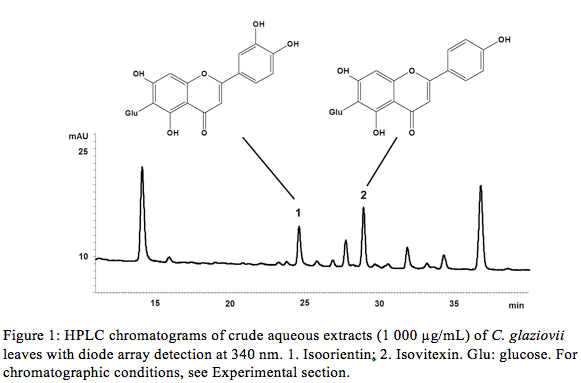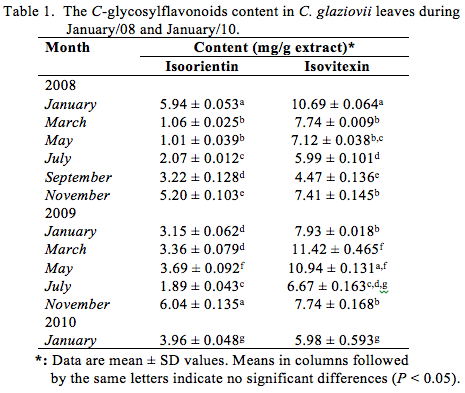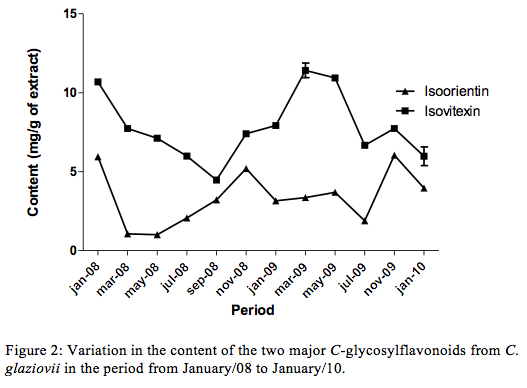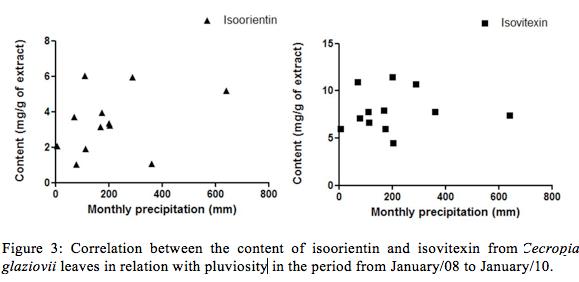Services on Demand
Journal
Article
Indicators
-
 Cited by SciELO
Cited by SciELO -
 Access statistics
Access statistics
Related links
-
 Cited by Google
Cited by Google -
 Similars in
SciELO
Similars in
SciELO -
 Similars in Google
Similars in Google
Share
Revista Colombiana de Ciencias Químico - Farmacéuticas
Print version ISSN 0034-7418
Rev. colomb. cienc. quim. farm. vol.43 no.1 Bogotá Jan./June 2014
https://doi.org/10.15446/rcciquifa.v43n1.45471
http://dx.doi.org/10.15446/rcciquifa.v43n1.45471
Artículo de investigación científica
Seasonal variations in the amount of isoorientin and isovitexin in Cecropia glaziovii Sneth. leaves over a two-year period
Variación estacionaria en el contenido de isoorientina e isovitexina en hojas de Cecropia glaziovii Sneth. durante un período de dos años
Geison M. Costa*, Caroline F. Ortmann, Eloir P. Schenkel, Flávio H. Reginatto2
*Programa de Pós-graduação em Farmácia, Departamento de Ciências Farmacêuticas, Universidade Federal de Santa Catarina, Campus Universitário Trindade, CEP 88040-900, Florianópolis, SC, Brazil. Correo electrónico: geison_costa@yahoo.com.br
Recibido para evaluación: Febrero 10 de 2014
Aceptado para publicación: Mayo 29 de 2014
SUMMARY
Cecropia glaziovii Sneth. (Urticaceae) is a common tree from Southeast and South of Brazil, being widely used in traditional medicine to treat heart and respiratory conditions. C-glycosylflavonoids have being described as the major compounds for this genus, however, no seasonality studies of individual flavonoids was conducted for any Cecropia specie. In this work, the content of isoorientin and isovitexin in aqueous extract from the leaves of C glaziovii during a two-year period was determined by high-performance liquid chromatography with diode array detector (HPLC-DAD). Seasonal alterations in the content of these two majority C-glycosylflavonoids as well its possible correlation with the pluviosity in the period of January/2008 to January/2010 were determined. Isoorientin presented higher content in November/09 (6.04 mg/g of extract) and lower content in May/08 (1.01 mg/g of extract). The higher content of isovitexin was observed in March/09 and the lower in September/08 (11.42 and 4.47 mg/g of extract, respectively). Although they have distinct behaviors, it was not observed correlation between the values of pluviosity and the production of these C-glycosylflavonoids.
Key words:Cecropia glaziovii - C-glycosylflavonoids - isoorientin - isovitexin - seasonality - HPLC-DAD
RESUMEN
Cecropia glaziovii Sneth. (Urticaceae) es un árbol comúnmente encontrada en el Suroriente y Sur de Brasil, siendo ampliamente utilizada en la medicina tradicional para el tratamiento de problemas cardíacos y respiratorios. Flavonoides C-glucósidos vienen siendo descritos como los compuestos mayoritarios del género, sin embargo, ningún estudio de estacionalidad de flavonoides analizados de modo individual fue realizado con ninguna especie de Cecropia. En el presente trabajo, el contenido de isoorientina e isovitexina en el extracto acuoso de las hojas de C. glaziovii durante un período de dos años fue determinado por HPLC-DAD. Variaciones estacionarias en el contenido de esos dos flavonoides C-glucósidos así como la posible correlación con la pluviosidad en el periodo de Enero/2008 hasta Enero/2010 fueron determinados. Isoorientina presentó mayor contenido en Noviembre/09 (6,04 mg/g de extracto) y menos contenido en Mayo/08 (1,01 mg/g de extracto). El mayor contenido de isovitexina fue observado in Marzo/09 y el menor contenido in Septiembre/08 (11,42 y 4,47 mg/g de extracto, respectivamente). Aunque los flavonoides poseen distintos comportamientos, no fue observada correlación entre los valores de pluviosidad y la producción de esos compuestos.
Palabras clave:Cecropia glaziovii - flavonoides C-glucósidos - isoorientina - isovitexina - estacionalidad - HPLC-DAD.
INTRODUCTION
Cecropia glaziovii Sneth. (Urticaceae) is a common tree from Atlantic Rain Forest in Southeast and South of Brazil, popularly known as "embaúba". Leaves from this species are used in the folk medicine to treat heart failure, cough, asthma, bronchitis and as diuretics [1-3]. About its chemical composition, previous studies had report the presence of terpenes, proanthocyanidins [4,5], but mainly C-glycosylflavonoids as one of the major compounds for the species [5-7].
It is described that the flavonoids may play an important role in some activities described for Cecropia species. For example, the hypotensive activity of the aqueous extract of C. glaziovii and the involvement of C-glysosylflavonoids, including isovitexin [8,9]; the hypoglycemic activity of isoorientin, presented in the leaves of C. obtusifolia [10]; the potential synergic effects of isoorientin and isovitexin in the anti-herpetic activity of aqueous extract from C. glaziovii leaves [11]; besides others activities such as anxiolytic [12], antidepressant [13], broncodilatation [14], antiulcer [15] and vasodilation [16], all described for C-glycosylflavonoid-enriched fraction.
Although literature reports a seasonal and intraspecific variation of total flavonoids and proanthocyanidins content in C. glaziovii by UV-VIS spectrophotometry [17], there are no seasonality studies of individual flavonoids in any Cecropia specie, especially for preparations used in the traditional medicine. The variation of these components is also an important factor to be studied for the future establishment of quality criteria for this medicinal plant.
This work presents a quantitative evaluation of the seasonality for two C-glycosylflavonoids (isoorientin and isovitexin) in the aqueous extract from C. glaziovii leaves over a two-year period.
METHODOLOGY
Chemicals
Isovitexin (4´,5,7-trihydroxyflavone-6-glucoside) and isoorientin (3´,4´,5,7-tetrahydroxyflavone-6-glucoside) were previous isolated from Cecropia glaziovii, and identified by TLC, UV, IR and 1H NMR spectrometry methods. The purity of these compounds was more than 98% [7]. Water was purified with a Milli-Q system (Millipore, Bedford, USA) and all solutions prepared for HPLC were passed through a 0.45 µm filter before use. Methanol, acetonitrile and acetic acid (HPLC-grade) were provided by Tedia® (Brazil).
Plant material
Leaves of C. glaziovii Sneth. were colleted in Florianópolis, SC, Brazil (27°35´52´´ S, 48°30´59´´ O), bimonthly, between January 2008 and January 2010. A similar number of leaves (3-4, depending on the leaf size) were randomly collected from the lower branches of the trees, avoiding as much as possible the variation on the age of the leaves within a collection. With the aim to reduce variation among leaves within a sample, we specifically avoided the hard and resected leaves. A voucher specimens (FLOR 37143) of the material are deposited in the Herbarium of the Botany Department of Universidade Federal de Santa Catarina, Florianópolis, Brazil.
Extraction
The different collections were treated and extracted with the same procedures. The leaves were dried under air flow in an oven between 30-35 °C and powdered mechanically. The infusion was prepared by adding 1000 mL of boiling water to 100 g of powdered leaves and allowing the extraction for 30 minutes. The extract was filtered, lyophilized and stored (-20 °C) until use.
HPLC analysis
Chromatographic analyses of the crude extracts were carried out in a PerkinElmer (Series 200) HPLC system, equipped with EP Diode Array Detection (DAD), quaternary pump, on-line degasser and autosampler. The data acquisition system was achieved by TotalChrom Workstation software. The methodology employed for these analyses was previously developed and validated by our research group [7]. Briefly, the separation was performed using a PerkinElmer Brownlee Choice C18 column (150 x 4,6 mm i.d.) and linear gradient combining solvent A (acetonitrile) and solvent B (acetic acid 1%, pH 3.0) as follow: 5-20% A (0-30 min) and isocratic 20% A (30-40 min). The flow rate was kept constant at 1.0 mL/min and the chromatograms were recorded at 340 nm while the UV spectra were monitored over a range of 450 to 200 nm. An aliquot of the lyophilized extract was dissolved in methanol:water (1:1 v/v) to obtain sample solutions for HPLC analysis, at a concentration 1.000 mg/mL. The injection volume was 10 µL. The peaks were characterized by comparing the retention time and UV spectra with the reference standards and by the co-injection of the sample and reference standards. Quantification of the individual compounds was performed using a six-point regression curve (r2 > 0.995). All samples and standard solutions were analyzed in triplicate and the peak average areas. The validation of analytical procedures was performed according to the ICH guidelines [18].
Statistical analysis
Data from seasonal variations were expressed as mean ± SD values of triplicates. Differences between treatments were compared by one-way analysis of variance, followed by Tukey´s test for approximately normally distributed variables. Data analyses were performed using the Prism software version 5.0 (GraphPad, La Jolla, USA), and the statistical significance was set at the 0.05 level (two-tailed) for both flavonoids. Pearson correlation test was employed to assess whether pluviosity influences the production of flavonoids.
RESULTS AND DISCUSSION
In previous works of our group, we were able to develop and validated an HPLC-DAD method to identify some phenolic compounds from C. glaziovii leaves, including majors C-glycosylflavonoids as isovitexin and isoorientin (Figure 1) [7]. These flavonoids could be potentials chemical markers since they presented good chemical stability [19], furthermore for their pharmacological relevance, evidenced in their putative involvement with the anti-herpetic activity exhibited for this extract [11] and also for their hypoglycemic [10] and hypotensor [8,9] activities. In this sense, the understanding of the seasonal behavior and the knowledge of the variations in the amount of these compounds could provide better parameters for the quality control of the extract and also contribute to the therapeutic efficiency of this medicinal plant, once that changes in the concentration of these active compounds could affect the pharmacological responses.
Although the HPLC fingerprint of the aqueous extract from the leaves of C. glaziovii presents a certain complexity, it was possible to analyze these two components individually. The analysis of crude aqueous extracts from Cecropia species did not show difference in the chromatographic fingerprint, but showed quantitative differences on the content of the majors C-glycosylflavonoids, specially isoorientin (Rt = 24.5 min) and isovitexin (Rt = 28.8 min). Another significant peak was observed in C. glaziovii extract (HPLC Rt > 35 min), which also present seasonal variation. Data about the UV profile of this peak suggests a flavone skeleton, with an apigenin nucleus, although this compound was not isolated, identified or quantified.
During the two-year period, the content of isoorientin was always lower than the content of isovitexin, although the behavior of their seasonality was different (Figure 2). The content of these compounds varied from 1.0 to 11.4 mg/g of extract,(Table 1).
Isoorientin showed the highest content in November/09 (6.04 mg/g of extract) and the lowest in May/08 (1.01 mg/g of extract). Considering isovitexin, the highest concentration was detected in March/09 (11.42 mg/g of extract), while the lower concentration was verified in September/08 (4.47 mg/g of extract) (Table 1).
The results indicate that the variation of the content of isoorientin seems cyclical, with higher production of this compound in the months of November each year. This behavior was not observed for isovitexin, whose seasonal variations showed, in general, the maximum contents in periods next to the months of January and March. Nevertheless, both C-glycosylflavonoids showed their maximum content in hot and long photoperiod seasons: spring and summer (November to March). This observation is consistent with the photoprotective role of phenolic compounds, including C-glycosylflavonoids, in defense of the vegetal [20,21].
In a previous study about seasonal variation of total flavonoids in C. glaziovii [17], the content of total flavonoids from a hydroethanolic extract (70%) of native leaves was significantly different between dry and rainy season. Our results, however, showed that the production specifically of isoorientin and isovitexin do not showed to be correlated with the pluviosity in the period (R2 = 0.1068, P = 0.2999; R2 = 0.0036, P = 0.8520, respectively) (Figure 3).
Menkovic and co-workers [22] propose that during the flowering phase, leaves of Gentiana lutea are rich with flavonoids possessing mainly C-glycoside structures. Our results showed that in this period the content of C-glycosylflavonoids is not the highest one in C. glaziovii leaves. The phase of flowering for this specie is since August to December [23], and in these months, it is possible to observe an increase in the content of isoorientin, while isovitexin showed the lowest content in September/08, which reinforces the distinct characteristic of isoorientin and isovitexin concerning its concentration in the plant.
Direct correlations of seasonal changes in the concentrations of flavonoids to herbivorous or physiological factors, which may function in the metabolic regulation of these compounds, were not considered here.
CONCLUSION
In this work we evaluated the possible alterations in the flavonoid composition from the aqueous extract of leaves of C. glaziovii, especially the isoorientin and isovitexin content in relation with seasonal variations. The results indicate quantitative variations during the period of analysis, with isoorientin presenting their maximum content in November/09 while the higher content of isovitexin was observed in March/09. It was not clearly observed a correlation between the pluviosity of the period and the production of these C-glycosylflavonoids.
These results contribute to a better knowledge about the quantitative chemical composition of the aqueous extract from the leaves of C. glaziovii, a wide consuming beverage in the traditional medicine in Brazil, being the data presented herein useful in future studies for the standardization of the extract.
ACKNOWLEDGEMENTS
This project was supported by CNPq (Grant: 475826/2008-6) and FAPESC (Grant: 008/2006). The authors also thank to Prof. Dr. Daniel Falkenberg identification of plant materials.
REFERENCES
1. P. Corrêa, "Dicionário das Plantas úteis do Brasil e das Exóticas Cultivadas", vol. 4, Imprensa Nacional, Rio de Janeiro, 1978. [ Links ]
2. C.C. Berg, P.F. Rosselli, "Cecropia. Flora Neotropica", The New York Botanical Garden, New York, 2005. [ Links ]
3. G.M. Costa, E.P. Schenkel, F.R. Reginatto, Chemical and pharmacological aspects of the genus Cecropia, Nat. Prod. Comm., 6(6), 931-920 (2011). [ Links ]
4. R.R. Oliveira, G.G. Leitão, M.C.C. Moraes, M.A.C. Kaplan, D. Lopes, J.P.P. Carauta, Gradient elution for triterpene separation from Cecropia lyratiloba Miguel by HSCCC, J. Liq. Chromatogr. R. T., 28, 1985-1992 (2005). [ Links ]
5. M.M. Tanae, M.T.R. Lima-Landman, T.C.M. De Lima, C. Souccar, A.J. Lapa, Chemical standardization of the aqueous extract of Cecropia glaziovii Sneth endowed with antihypertensive, bronchodilator, antiacid secretion and antidepressant-like activities, Phytomedicine, 14, 309-313 (2007). [ Links ]
6. M.A. Lacaille-Dubois, U. Franck, H. Wagner, Search for potential Angiotensin Converting Enzyme (ACE)-inhibitors from plants, Phytomedicine, 8, 47-52 (2001). [ Links ]
7. G.M. Costa, C.F. Ortmann, E.P. Schenkel, F.H. Reginatto, An HPLC-DAD Method to Quantification of Main Phenolic Compounds from Leaves of Cecropia Species, J. Braz. Chem. Soc., 22(6), 1096-1102 (2011). [ Links ]
8. M.T.R. Lima-Landman, A.C.R Borges, R.M. Cysneiros, T.C.M. De Lima, C. Souccar, A.J. Lapa, Antihypertensive effect of a standardized aqueous extract of Cecropia glaziovii Sneth in rats: An in vivo approach to the hypotensive mechanism, Phytomedicine, 14, 314-320 (2007). [ Links ]
9. R.M. Cysneiros, "Mecanismo da ação hipotensora do extrato aquoso e frações purificadas da Cecropia glazioui Sneth.", PhD Thesis, Universidade Federal de São Paulo, São Paulo, Brazil (1996). [ Links ]
10. A. Andrade-Cetto, H. Wiedenfeld, Hypoglycemic effect of Cecropia obtusifolia on streptozotocin diabetic rats, J. Ethnopharmacol., 78, 145-149 (2001). [ Links ]
11. I.T. Silva, G.M. Costa, P.H. Stoco, E.P. Schenkel, F.H. Reginatto, C.M.O. Simões, In vitro antiherpes effects of a C-glycosylflavonoid enriched fraction of Cecropia glaziovii Sneth, Lett. Appl. Microbiol., 51, 143-148 (2010). [ Links ]
12. F.F. Rocha, A.J. Lapa, T.C.M. De Lima, Evaluation of the anxiolytic-like effects of Cecropia glazioui Sneth in mice, Pharmacol. Biochem. Behav., 71, 183-190 (2002). [ Links ]
13. F.F. Rocha, M.T.R. Lima-Landman, C. Souccar, M.M. Tanae, T.C.M. De Lima, A.J. Lapa, Antidepressant-like effect of Cecropia glazioui Sneth and its constituents - In vivo and in vitro characterization of the underlying mechanism, Phytomedicine, 14, 396-402 (2007). [ Links ]
14. S. Delarcina Jr., M.T.R Lima-Landman, C. Souccar, R.M. Cysneiros, M.M Tanae, A.J. Lapa, Inhibition of histamine-induced bronchospasm in guinea pigs treated with Cecropia glaziovi Sneth and correlation with the in vitro activity in tracheal muscles, Phytomedicine, 14, 328-332 (2007). [ Links ]
15. C. Souccar, R.M. Cysneiros, M.M Tanae, L.M.B Torres, M.T.R Lima-Landman, A.J. Lapa, Inhibition of gastric acid secretion by a standardized aqueous extract of Cecropia glaziovii Sneth and underlying mechanism, Phytomedicine, 15, 462-469 (2008). [ Links ]
16. R.R. Almeida, J.M. Raimundo, R.R. Oliveira, M.A.C. Kaplan, C.R. Gattass, R.T. Sudo, G. Zapata-Sudo, Activity of Cecropia lyratiloba extract on contractility of cardiac and smooth muscles in Wistar rats, Clin. Exp. Pharmacol. Physiol., 33, 109-113 (2006). [ Links ]
17. P.E. Luengas-Caicedo, F.C. Braga, G.C. Brandão, A.B. Oliveira, Seasonal and intraspecific variation of flavonoids and proanthocyanidins in Cecropia glaziovi Sneth. leaves from native and cultivated specimens, Z. Naturforsch., 62, 701-709 (2007). [ Links ]
18. ICH - International Conference on Harmonization. Validation of Analytical Procedures: Text and Methodology - Q2(R1), London, 2005. [ Links ]
19. C.F. Ortmann, "Avaliação da estabilidade de extratos, frações e flavonoides C-glicosídeos presentes em Cecropia glaziovii", Tesis de Maestria, Universidade Federal de Santa Catarina, 2013, p.113. [ Links ]
20. J.B. Harborne, "The flavonoids: Advances in research since 1986", Chapman & Hall/CRC, London, 1994. [ Links ]
21. J.H. Yariwake, F.M. Lancas, E.A. Cappelaro, E.C. Vasconcelos, L.A. Tiberti, A.M.S. Pereira, S.C. Franca, Variabilidade sazonal de constituintes químicos (triterpenos, flavonóides e polifenóis) das folhas de Maytenus aquifolium Mart. (Celastraceae), Braz. J. Pharmacog., 15(2), 162-168 (2005). [ Links ]
22. N. Menkovic, K. Savikin-Fodulovic, K. Savin, Chemical composition and seasonal variation in the amount of secondary compounds in Gentiana lutea leaves and flowers, Planta Med., 66, 178-180 (2000). [ Links ]
23. H. Lorenzi, F.J.A. Matos, "Plantas Medicinais no Brasil: Nativas e Exóticas", Instituto Plantarium de Estudos da Flora Ltda, Nova Odessa, Sao Paulo, 2008. [ Links ]

















